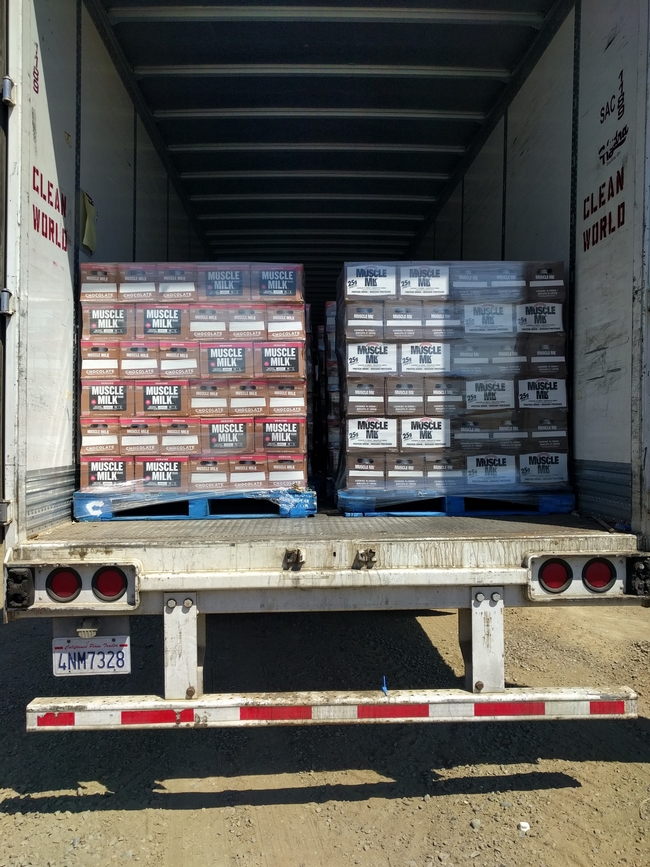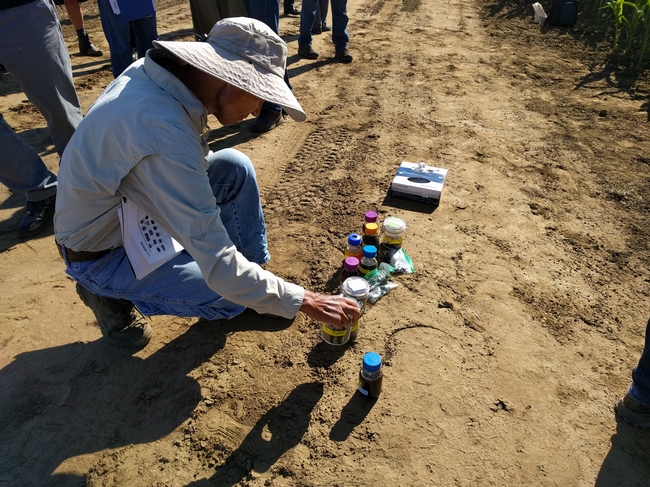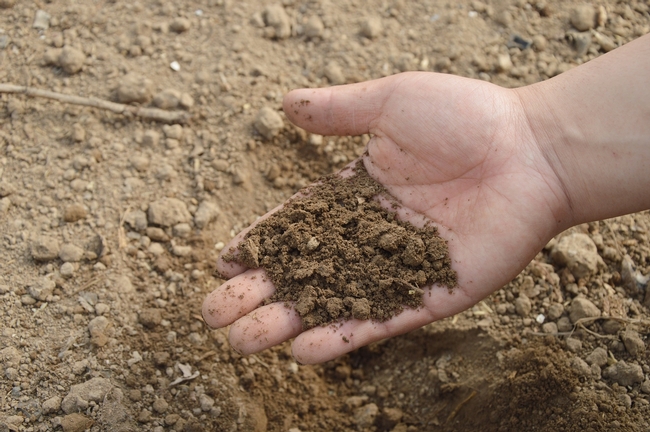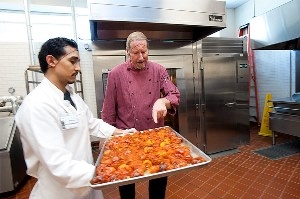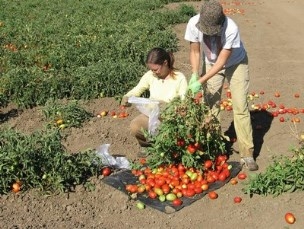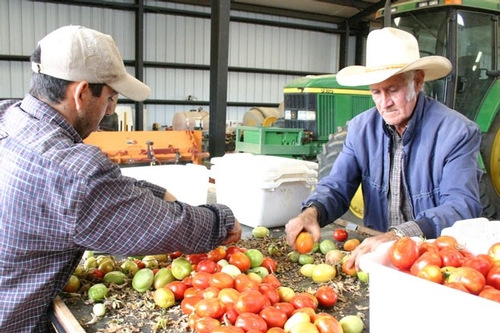Posts Tagged: Russell Ranch
Biodigesters turn food into electricity, but can they also create fertilizer?
On a recent late-summer Wednesday, a freight container filled with cases of expired Muscle Milk protein drink awaited unloading at the UC Davis Renewable Energy Anaerobic Digester (READ) while a front-loader scooped heaps of spoiled vegetables into a mechanical processor. Nourished by a diet of assorted food waste from the UC Davis campus and area restaurants and markets, READ harnesses the activity of billions of microbes to produce biogas capable of generating 5.6 million kWh per year of clean electricity for UC Davis.
But a by-product of READ and other anaerobic digesters – the slurry of leftover solid and liquid material, or digestate – has caught the attention of UC Davis researchers interested in “closing the loop” on food production, consumption, and waste. When processed through an anaerobic digester, organic materials like food discards, expired or off-spec food products, or animal manure can be transformed into concentrated biofertilizers and soil amendments that are highly effective and easily applied to crops.
In an interdisciplinary collaboration at the Russell Ranch Sustainable Agriculture Facility, funded by the California State Water Resources Control Board and the California Department of Food and Agriculture, UC Davis faculty and students have developed a pilot-scale process for commercial production of several forms of this biofertilizer using digestate from READ and other nearby digesters. They are also evaluating their effects on yield and other agronomic metrics in corn and tomato field trials – paving the way for farmers and growers to take advantage of a highly sustainable source of plant nutrition.
The challenge and opportunity of fertilizer from anaerobic biodigesters
The digestate from READ and other digester facilities can be applied directly to soil as a fertilizer, but, because it has a limited shelf-life, it usually must be applied to land in the immediate region of the facility. With the input of food waste that can vary widely from day to day, a facility's digestate is inconsistent in texture and composition, making it difficult to transport and apply to fields using common farm fertilizer equipment.
Filtering and drying this digestate, however, results in solid and liquid forms that can be concentrated, homogenized, easily transported, and applied to soil through existing drip irrigation systems or surface spreading equipment.
This process could allow farmers and growers located further away, and working with common irrigation and fertilizer application equipment, to supplement or replace their synthetic fertilizer consumption with biofertilizers from food waste or animal manure.
How do biodigestate products measure up to synthetic fertilizers?
The research, co-led by professor Ruihong Zhang from the UC Davis Department of Biological and Agricultural Engineering (who also designed READ in partnership with Sacramento-based tech company CleanWorld) and Professor Kate Scow from the Department of Land, Air, and Water Resources, developed pilot-scale systems to efficiently and consistently separate the solid and liquid portions of food- and manure-based digestates. The researchers then examined the nutrient composition of the solid and liquid biofertilizer products, finding that biodigestate-based fertilizers contain valuable nutrients and microbes not found in many synthetic fertilizers.
In current field trials, the researchers are investigating the effects of each of the biofertilizer products on crop yield and quality. Their preliminary results show that it is possible to grow irrigated processing tomatoes and short-season corn using biofertilizer products as the sole source of fertilizer. The origin of the fertilizer matters, however – manure-based liquid fertilizer formed additional large particles after the final filtration, creating concerns about clogging the drip irrigation system. The team thinks an environmentally benign chemical sometimes added to manure digesters to clean the biogas may be the culprit of the problem, but future research is needed. The solid biofertilizer pellets they developed show much promise, as they can be applied using existing methods for spreading compost and can be economically transported farther away from the digester.
In addition to better understanding the best processes for producing and using the biofertilizers, further research is needed to understand how much of the nitrogen in each of the fertilizer products is available for uptake by the crop, as well as economic analyses to determine the commercial-scale production and transportation costs. The researchers will be able to narrow in on the agronomic and economic potential of biofertilizers through the upcoming analysis of the yield of the corn and tomato experiment plots at Russell Ranch. The results of a tomato experiment recently showed that the digestate fertilizers produced just as much fruit as a popular synthetic fertilizer.
Interdisciplinary research for agricultural innovations
Russell Ranch, a program of the Agricultural Sustainability Institute, is designed as a shared space for interdisciplinary research and innovation. The biofertilizer research, among other active projects at Russell Ranch, is an example of the fulfillment of that intention. “The soil scientists are learning engineering, the engineers are learning biology, and the biologists are learning about soil,” Professor Zhang remarked.
The exchange also extends beyond the university: a recent UC Davis Biofertilizer Field Day drew attendees from the UC Division of Agriculture and Natural Resources, several public agencies, the agricultural sector, other universities, nonprofits, entrepreneurs, and food processors. If the research continues to illuminate a way forward for biofertilizers, these audiences may fill important roles in bringing this new technology into practice – and in recycling your lunch leftovers back into a more efficient and sustainable food system.
More information: UC Davis READ, Russell Ranch, and the biofertilizer research
The UC Davis Renewable Energy Anaerobic Digester was unveiled in 2014 as the nation's largest anaerobic biodigester on a college campus, and represented a unique private-public partnership. Professor Ruihong Zhang invented the anaerobic digestion technology used by CleanWorld, which developed it into one of the most advanced commercially-available digester systems in the country.
Russell Ranch Sustainable Agriculture Facility is a “living laboratory” for interdisciplinary field research and innovation. Its flagship project, the Century Experiment, measures the long-term impacts of energy, water, carbon, and nitrogen inputs on agricultural sustainability in the flagship Century Experiment.
The biofertilizer research collaboration includes Zhang Lab graduate students Tyler Barzee and Hossein Edalati, Scow Lab postdoctoral researcher Daoyuan Wang, and Russell Ranch manager Israel Herrera. Collaborating institutions include CleanWorld, California Bioenergy, New Hope Dairy (Galt, CA), Fiscalini Dairy (Modesto, CA), and Sacramento Municipal Utility District.
This story en español.
Fighting drought with soil
A team of University of California scientists recently received a $1.69 million grant to use several UC agricultural research stations to study an often overlooked tool to fight the drought: soil.
The team, led by Samantha Ying, an assistant professor of environmental sciences at UC Riverside, received the grant from the University of California Office of the President.
The funding will allow for the establishment of the University of California Consortium for Drought and Carbon Management (UC DroCaM), which will design management strategies based on understanding soil carbon, the soil microbiome and their impact on water dynamics in soil.
The researchers will conduct field and lab research on microbiological, biophysical, and geochemical mechanisms controlling soil formation and stability under different row crops (tomatoes, alfalfa, wheat), farming practices (carbon inputs and rotations) and irrigation methods (furrow and flood, microirrigation).
Information on mechanisms will be integrated into a regionally-scalable predictive model to describe soil carbon dynamics and estimate the response of agricultural systems to drought.
Field research will initially be conducted at three UC Research and Extension Centers (Kearney, West Side and Desert) the Russell Ranch Sustainable Agriculture Facility near UC Davis.
Recommendations will then be made for broader monitoring and field experiments throughout the state based on input gained from local growers and citizens at workshops at the agricultural research stations. Ultimately, the hope is to expand and involve all nine research and extension centers from the Oregon border to the Mexican border.
“Having agricultural research stations throughout the state is a huge part of this project,” Ying said. “It is going to help us create one of the best research centers in the country focused on soil and drought.”
There is also a public engagement component. Citizens will be recruited to participate in workshops to learn how to monitor and sample their local soils. Information will then be imputed into an online soils database that will help create a map of the biodiversity of agricultural soils in California.
Ying's collaborators are: Kate Scow and Sanjai Parihk (UC Davis); Eoin Brodie and Margaret Torn (UC Berkeley); Asmeret Berhe and Teamrat Ghezzehei (UC Merced); and Peter Nico and William Riley (Lawrence Berkeley National Laboratory).
The grant is one of four awards totaling more than $4.8 million from University of California President Janet Napolitano's President's Research Catalyst Awards.
UC Davis tomatoes provide year-round healthful eating for college students
At the same time, chefs and food buyers at universities, particularly the University of California, are selecting for high-quality fruits and vegetables, produced locally and sustainably. Universities with strong food sustainability programs are rightfully proud of what they're doing to educate students about food production, health, and nutrition. UC Davis Dining Services prioritizes the purchase of locally grown food (ideally within a 50-mile radius of campus). Most University of California campuses have similar programs.
At UC Davis, fresh roma tomatoes are picked each August from the 300-acre Russell Ranch, part of the campus's Agricultural Sustainability Institute, then processed within hours by campus Dining Services to provide year-round tomato sauce for pizza, pasta, and ratatouille. All told, 10,000 pounds of tomatoes are processed during a two-week period in August. About 29 percent of the total food served in the campus's residential dining halls is from local, organic or sustainable sources.
The tomatoes grown at Russell Ranch are part of a long-term academic research project that examines factors such as farming methods, irrigation needs, crop rotations, yield, and nutritional content. At the end of the growing season, some of the many tons of tomatoes are purchased by Dining Services at market value.
Emma Torbert, an academic coordinator at the UC Davis Agricultural Sustainability Institute, noted, “Connecting the food system to the research is really interesting. A lot of times there is confusion about where our food is coming from. The more people are educated, the more educated decisions they can make.”
Many UC Davis faculty and staff are so impressed with the food choices at the dorms that they purchase individual meal tickets and enjoy lunches made with the campus-grown tomatoes, herbs, and other vegetables, all of which are part of the daily food array. Public dinners are also offered periodically at the dorms so that community members can sit amongst students to taste and learn about the sustainability programs in the dorms.
Additional Information:
- Video: Farm to Table, UC Davis Tomatoes; 2010
- Slide show of this year's UC Davis tomato harvesting and processing system; 2014
- Sustainable Foodservice Progress Report 2014, UC Davis Dining Services
- Two videos of UC Davis students who work at the Student Farm to produce food, including one on tomato sauce production
- “Tomatoes: Safe methods to store, preserve, and enjoy.” UC Agriculture and Natural Resources, free publication
Russell Ranch digs deep
Approximately every ten years, the research team at the Russell Ranch Sustainable Agriculture Facility at UC Davis gets the chance to dig deep into their research material to help answer questions about the long-term sustainability of agricultural systems.
With a steel probe attached to the back of a tractor, the team digs three meters deep to take soil samples at 432 different points around the 72-acre field. The initiative takes the team nearly a month to complete, and the information in each soil core can answer major research questions about the long-term effects of different farming methods on soil health and help inform year-round research efforts at the ranch.
“The effort that has gone into collecting this unique set of samples will pay off in figuring out agricultural impacts on processes happening not only in plain sight, but also out of view, buried deep in the soil,” said Russell Ranch director Kate Scow.
The sampling effort is part of the Century Project, Russell Ranch’s 100-year-long experiment. The project divides 72 acres of land into individual one-acre plots, with each plot given different treatments throughout the year. Some plots are irrigated; other plots are farmed without added water. Some plots are treated with compost; others are treated with synthetic fertilizer. Each individual plot demonstrates how a combination of different practices can affect crop yield, soil health and the health of surrounding ecosystems.
The 10-year sampling is a comprehensive look at the system, meant to serve as a baseline in determining the soil health at Russell Ranch. And there are a lot of factors that influence soil health. The research team tests for changes in soil organic matter, organic nitrogen, phosphorous, and other elemental content. They also test for bulk density (the amount of compaction in the soil), moisture content, and the microbial community at different soil depths.
Too, the soil sampling efforts dig deeper in the soil than much research, bringing important new information to soil science.
“Historically, much of the research has focused on the top 15 to 30 centimeters of soil. Some previous ideas about the distribution of carbon in the soil and effects of tillage on soil health have been wrong because of this,” said Scow.
With the Century Project in its 19th year, the 2012 soil samples are the third out of 11 field-wide samples to be taken over the course of the project. Changes to soil can happen slowly, so a long-term focus allows researchers to update their research as new information and new technologies become available.
“The big questions scientists are asking have changed, so we’re hoping to implement a new set of research questions that will drive us for the next 20 years,” said Emma Torbert, post-graduate fellow at Russell Ranch. “The benefit of long-term research is that we are provided the time to respond to those changing questions.”
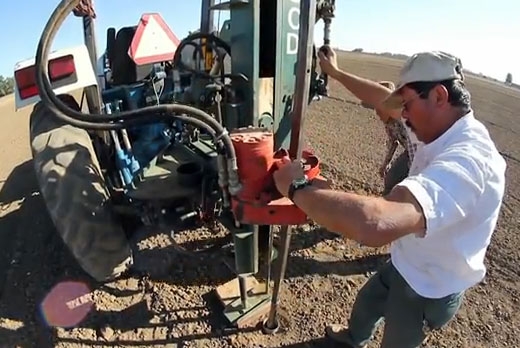
Taking a soil sample at UC Davis' Russell Ranch.
What makes food nutritious?
Workers sort tomatoes at Russell Ranch
Part of our mission at the Agricultural Sustainability Institute at UC Davis is to ensure access to healthy food. So we’ve focused much of our work on the intersection between agriculture and human nutrition.
An interesting new field of study in this area looks at flavonoids, which are compounds in fruits and vegetables thought to have beneficial antioxidant effects and other medicinal value – they may even help reduce cancer risk.
Measuring the amount of flavonoids is one way we can figure out just how nutritious the food we’re eating really is.
At our Russell Ranch Sustainable Agriculture Facility, UC Davis Food Science professor Alyson Mitchell has looked at the relative nutrition of organic and conventional tomatoes by measuring flavonoid levels in samples from dried tomatoes over a 10-year period.
Aerial view of Russell Ranch Sustainable Agriculture Facility
She found that flavonoid content is greater in organic than conventional tomatoes, and the differences have increased with time. Over time, it also appears that an increase in flavonoid content is correlated with lower amounts of organic nitrogen application.
These results suggest that over-fertilization can result in lower flavonoid content – and a reduction in the health benefits of tomatoes. You can find out more about this research here.

